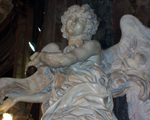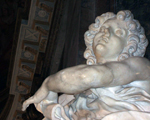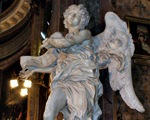A BIT IN DEEP: BERNINI
When Carlo Maderno's died in 1630, old and nearly blind, Pope Urbano VIII called Gian Lorenzo Bernini to collaborate with Borromini, who was the main aid of Maderno, to complete the Barberini Palace.
Hard to imagine two more contrasting natures, and how easy it was to be expected eventually became rivals bitterly.
A funny example of this rivalry is narrated by Guattani in his "ancient monuments, or news about the antiques and fine art in Rome" (1787). The premise is that Bernini lived in that palace in Via della Mercede, where today we see a bust of him, the fact is that this building is dominated by two masterpieces by Borromini, the Palace of Propaganda Fide and the bell tower of Sant'Andrea delle Fratte.
Bernini did not like.
Guattani writes: "The bizarre and capricious Bernini gave the form of a phallus to a support that still holds a balcony on the corner of his home, to jeer Borromini, who on the opposite corner of the palace of Propaganda Fide in the coats of arms of the Pope, placed two donkey ears to mock his opponent".
Later ended up that the authorities did not appreciate the dialectic style and these amusing ornaments were removed.
Indeed Bernini did not disdain some scurrility, as evidenced by the little elephant in Minerva square, whose implementation was entrusted by Dominicans to Gian Lorenzo, disappointing expectations of one of their brothers. This one, in revenge, asserted that the elephant would not be able to support the small obelisk above. Bernini was then forced to hide under a blanket a block of travertine, used to support the elephant, in contrast, the elephant is carved in a pose somewhat ambiguous, it seems to show the backside towards the windows where the disappointed Dominican lived.
During the papacy of Urban VIII Barberini, Bernini had carte blanche, so to speak, and the tomb of Cecilia Metella ran a good (or bad), risk ‘since the Pope, authorized Bernini to demolish the mausoleum in order to obtain "the beautiful marble."
The Romans rose up and Cecilia Metella was saved.
About Four Rivers Fountain, Bernini's opponents, since the obelisk rests on a thin slab of travertine, triggered a controversy about its static, provident Bernini reassured everyone one morning coming in the square with his assistants and anchoring the obelisk to the nearby buildings with a silk thread.
That lack of static was a charge launched against Bernini and sometimes reasonably i.e. he had erected a tower on the facade of St. Peter's Basilica, which just for static problems was shot down.
While over the dome of the Pantheon he had erected two towers, not exactly loved by the Romans, who named them the "donkey ears". These were demolished after his death.
Bernini architect owes its fame mainly to the brilliant colonnade of St. Peter's Square and the Church of Sant'Andrea al Quirinale, but, as he said himself, his preference was sculpture.
 |
 |
 |
 |
| The angels of Sant'Andrea delle Fratte -
click to enlarge |
In Rome, many are his works, in which he shows a solar love for beauty, enhanced by the carnality of his marbles. The angels of Sant'Andrea delle Fratte are one of the best examples, but the work that, more than any other, symbolizes the sculpture of a whole century is the Cornaro Chapel in Santa Maria della Vittoria.
|
| The Cornaro Chapel at Santa Maria della Vittoria |
back |

